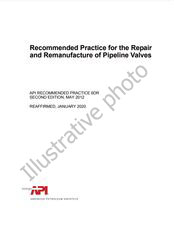We need your consent to use the individual data so that you can see information about your interests, among other things. Click "OK" to give your consent.

API PUBL 4661-ed.2
Exploration and Production Emission Calculator II (EPEC II) User’s Guide
Translate name
STANDARD published on 1.1.2007
| Language | |
| Format |
|
| Availability | IN STOCK |
| Price | ONREQUEST excl. VAT |
| ON REQUEST |
The information about the standard:
Designation standards: API PUBL 4661-ed.2
Publication date standards: 1.1.2007
SKU: NS-1139824
The number of pages: 110
Approximate weight : 361 g (0.80 lbs)
Country: American technical standard
Category: Technical standards API
Annotation of standard text API PUBL 4661-ed.2 :
API PUBL 4661, 2nd Edition, January 2007 - Exploration and Production Emission Calculator II (EPEC II) User’s Guide
INTRODUCTION
The Exploration and Production Emission Calculator Version 2.0 (EPEC II) is a software tool that can be used to estimate emissions for exploration and production (E&P) facilities. EPEC II integrates user inputs, emission calculations, and data summaries for many equipment types common to E&P facilities. The calculation techniques and emission factors utilized by the EPEC II software were, in most cases, established by the U.S. Environmental Protection Agency (EPA), the American Petroleum Institute (API), and the Gas Research Institute (GRI). Published references that provide background information for the calculation methods used in EPEC II are given for each equipment type in both the software and in each section of this Users Guide. EPEC II can be used to estimate emissions of criteria pollutants (carbon monoxide [CO], nitrogen oxides [NOx], sulfur oxides [SOx], particulate matter under 10 µm [PM10], and volatile organic compounds [VOCs]), hydrogen sulfide (H2S), greenhouse gases (GHGs—carbon dioxide [CO2], methane, and ethane), and hazardous air pollutants (HAPs), such as benzene, toluene, ethylbenzene, xylenes, 1,3-butadiene, n-hexane, 2,2,4-trimethylpentane, formaldehyde, and acetaldehyde. The types of equipment addressed by the EPEC II software include amine units, cooling towers, diesel/gasoline internal combustion (IC) engines, external combustion emission units, fixed-roof storage tanks, flares, fugitive emissions, glycol dehydrators, loading operations, natural gas engines, natural gas turbines, and vents. The user also has the flexibility to include emissions from additional equipment types, or to use alternative means to calculate emissions.
We recommend:
Technical standards updating
Do you want to make sure you use only the valid technical standards?
We can offer you a solution which will provide you a monthly overview concerning the updating of standards which you use.
Would you like to know more? Look at this page.



 Cookies
Cookies
